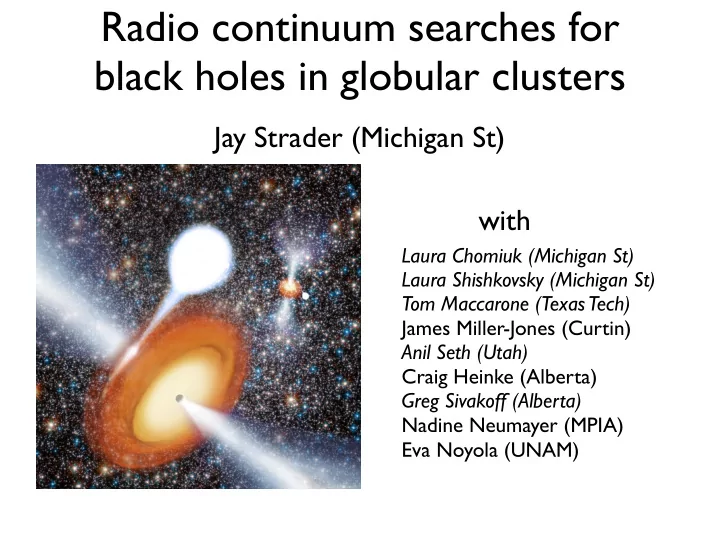

Radio continuum searches for black holes in globular clusters Jay Strader (Michigan St) with Laura Chomiuk (Michigan St) Laura Shishkovsky (Michigan St) Tom Maccarone (Texas Tech) James Miller-Jones (Curtin) Anil Seth (Utah) Craig Heinke (Alberta) Greg Sivakoff (Alberta) Nadine Neumayer (MPIA) Eva Noyola (UNAM)
Low-mass X-ray binaries Accretion onto a compact object (neutron star or black hole) produces X-ray, optical, and radio emission
Radio & X-ray for BHs For BHs with low Corbel et al. 2013 accretion rates, L r ~ L x0.6 radio detection increasingly efficient Jonker/Hynes L r L x
Why Now? The VLA upgrade Bandwidth is 20x higher than old VLA: an enormous upgrade for radio continuum observations just by changing the electronics
How Non-detections Look 1 pc M19 VLA
M22: Central sources Strader et al. 2012 flux density ~ 55-60 uJy flat spectrum: S ~ v 0.0-0.2 central spatial location no X-rays VLA Chandra
Still not X-ray detected in new simultaneous Chandra data, have L X < 5 x 10 29 erg/s
Radio & X-ray Miller-Jones, JS et al., 2015 radio/X-ray ratio suggests these are BHs
Radio & X-ray Miller-Jones, JS et al., 2015 transitional MSP/LMXB appear to follow offset relation
Optical Counterparts? Strader et al. 2012 ~ 0.34 M WD?
Radio Proper Motions for M22 Sources Would completely rule out background sources Keep trying (and being foiled) at getting a clean 2nd epoch of data 46 +/- 6 uJy
M62: A nicer BH candidate 25” Chomiuk et al 2013 VLA Chandra (only 19 uJy!) power-law X-ray spectrum:
Radio & X-ray Redux Miller-Jones, JS et al., 2015 similar to V404 Cyg (longish period for BHXB) optical match is a red giant possible to get AO RVs: first set taken
A candidate in 47 Tuc 20” Miller-Jones, JS, et al 2015 ATCA Chandra
Radio & X-ray Miller-Jones, JS et al., 2015
Optical Data Optical counterpart is well-known UV- bright variable, with a UV HST spectrum HST (275W) HST (814W) Knigge et al. 2008 no He 1640 CIV
X-ray Data Heinke et al 2005 Unusual X-ray spectrum, consistent with the presence of OVIII emission
47 Tuc X9 in addition, there is a good upper limit on H- alpha emission from narrow-band HST photometry presence of C/O emission with no H/He emission suggests donor is a CO WD an HST broadband spectrum could rule out H emission and provide more evidence for ultracompact interpretation
M10 POSTER BY LAURA SHISHKOVSKY flat-spectrum radio source within core of cluster deep Chandra data will be taken this cycle (L X < 6 x 10 32 ) red giant counterpart
Population Conclusions? among BH candidate secondaries: 2 RGB stars, 1 MS star, 1-2 WDs, 1 sub-subgiant median distance of GC with BH candidates is 4 kpc: suggests search is sensitivity limited, and thus a large population of candidate BHs
Recommend
More recommend